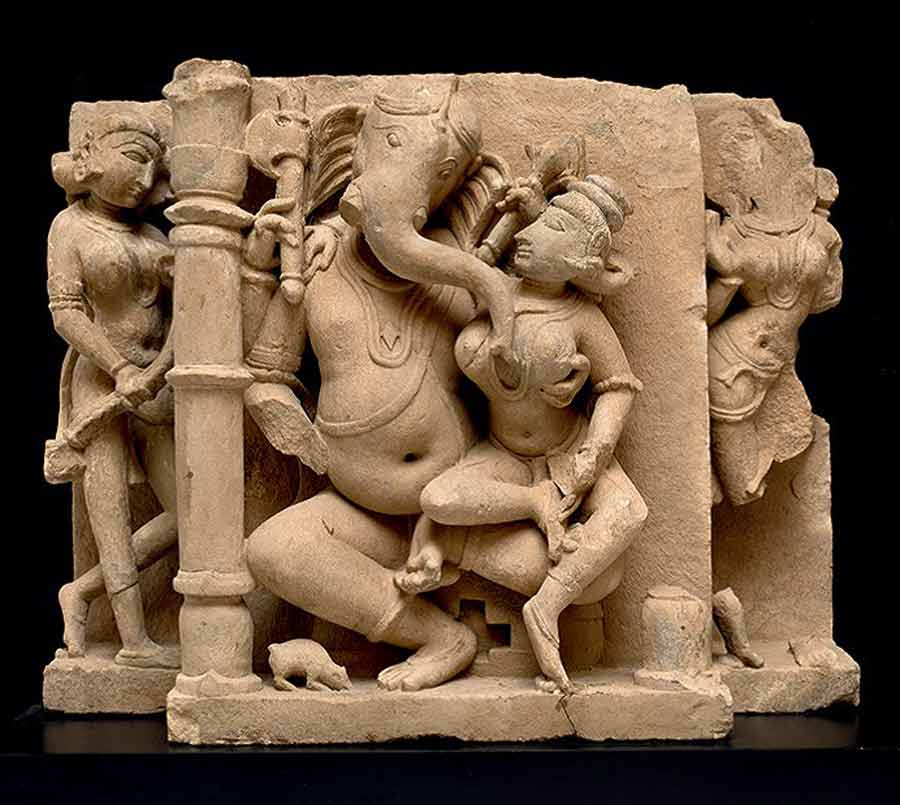
Temple Sculpture Representing Ganesha and His Spouse with two female attendants beyond the columns, India, Madhya Pradesh, 12th century Sandstone Cat. 103.
God as Yogi
The earliest evidence for yoga is found not in texts but rather in art, in the material remains of the Indus, or Harappan, civilization. Much later it was
this renunciate /ascetic tradition that was predominant in the philosophical literature known collectively as Upanishad, out of which—and in antagonism to
Vedic sacrificial rituals—emerged Jainism and Buddhism, as well as theistic Hinduism. The geographic source of this thought process, however, belonged far
to the east of the sites of the Harappan civilization: in the lower Gangetic plains and largely among the warrior class known as kshatriya, rather
than among the higher priestly class of brahman (adopted in English as Brahmin with a capital B as in “Boston Brahmins”). [1]
Both Vardhamana Mahavira and Buddha Shakyamuni belonged to the kshatriya class, as did many of the Upanishadic teachers and
thinkers themselves. Both renounced the life of a householder and took to the road in search of enlightenment, practiced austerities, and adopted yogic
meditation as the means of attaining liberation (moksha, kaivalya, nirvana, etc.).
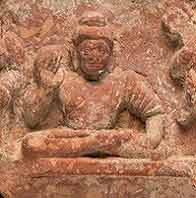
Fig. 13 Detail of stone fragment showing worship of meditating Buddha Shakyamuni, Uttar Pradesh, 2nd century. Cat. 150.
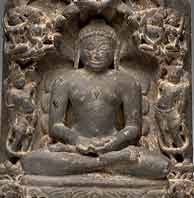
Fig. 14 Detail of stone stele of Jina Parshvanatha seated in yogic posture, Karnataka, 13th century. Cat. 117.
Accordingly the earliest figures of Buddha and the Jina are both represented without earthly trappings and as ideal yogis and monks (fig. 13, cat. 150;
fig. 14, cat. 117). In keeping with the greater emphasis on renunciation in Jainism, the Jina is either scantily attired or completely naked, while the
Buddha is clad in three pieces of monastic garb. Indeed, as noted above, this sartorial issue caused a fissure within the Jain community, which is why
early representations of the Jinas (down to the 6th century ce) demonstrate the utter disdain, befitting the liberated Jina, for any form of materiality
and sensuality. [2]
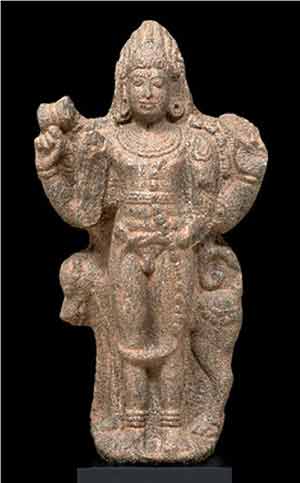
Fig. 15 Stone image of Bhairava, Tamil Nadu,
14th–15th century. Cat. 77.
The image of the Jina in Indian art is the most spiritual, abstract, and detached in the contextuality of human form. Indeed,
even in the earlier art of the pre-Buddhist and -Jain period, whether male or female, the human figure is never conceived as realistic or physically ideal
as in Greek sculpture. Rather, it is depicted with a looser body and more flexible limbs and smooth flesh in keeping with the body of a yogi, which is
never muscle-bound and taut. The difference is easily perceptible by comparing a Gandhara and a Mathura Buddha image (see cats. 150 and 151).
Less stylized
and more sensuous than the Jina statue, the Buddha figure is characterized by a much greater diversity of gestures and postures. In early art, the Buddha
is still a historical person, and important life events are never forgotten, being subtly alluded to with hand gestures. In the many forms of the
transcendental Buddhas of later Buddhism as the religion became elaborate, the traces of historicity were abandoned in favor of symbolic meaning.
Iconographic variations are much greater in Buddha images than in those of Jinas, but no matter how they are distinguished from ordinary mortals with
extrasensory bodily signs of a mahapurusha (a great person) and divinized with provision of a nimbus or halo, they are never given multiple arms
and hands, which is one of the most indisputable methods of distinguishing the divine from the mortal in the Indian mythic mind.
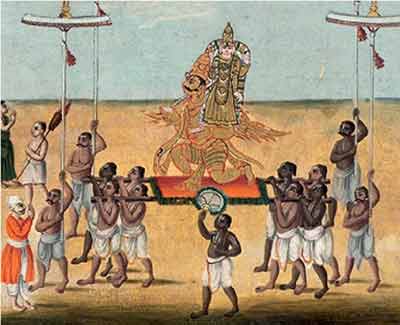
Fig. 16 Vishnu on Garuda (detail), Karnataka, early 19th century. Cat. 20.
In the Hindu pantheon, the God Shiva is the ascetic yogi par excellence, but his images, even in the limited examples in the exhibition, reflect an
enormous variety of forms (cats. 66–78). The most notable iconographic feature of his renunciate character is of course his matted hair, yet he is
portrayed as a handsome youth. His third eye on the forehead, the source of his cosmic rage and energy, is not always present. By and large, he is
conceived as a combination of a householder, frequently with his spouse Parvati, or Uma (who, like him, assumes wrathful forms as required), and a
renunciate. Even in his angry or Bhairava form (cat. 74; fig. 15, cat. 77), he does not lose his youthfulness.
The concept of yoga is also closely associated with the God Vishnu as in such iconographic forms as Yogavishnu, Yoganarasimha, and Yognarayana. In fact, as
early as the Mahabharata, in the story of the sojourn and conversation in the Himalayan ashram called Badari between Nara (Man) and Narayana (one who inheres in Man), both are represented as yogis, as they also are in art. [3] Narayana is also the name of the supreme form of Vishnu in the Pancharatra belief system (a
highly ascetic branch of Vaishnavism), and in his recumbent image in the cosmic ocean on a couch formed by the cosmic serpent Ananta (Eternity), he is said
to be in yoganidra, or meditative sleep (cat. 21). The pervasive influence of yoga is also encountered with the Devi or Durga such as Yogamaya (maya meaning “illusion”).
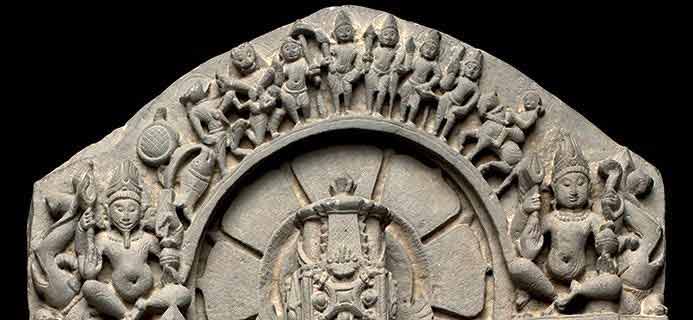
Fig. 17 Detail of arch above Vishnu image showing Brahma, Shiva, and Dashavatara, Rajasthan, ca. 11th century. Cat. 15.
God as Ruler and Protector
Apart from the yogi, the mendicant, or the ascetic, the earthly ruler or the king, too, served as a model for the Gods of Indian mythologies from ancient
times. The Vedic Indra, powerful king of the Gods, was given the elephant as his mount, the most enduring symbol of regal grandeur on the subcontinent.
When the Greek conqueror Alexander confronted King Puru (Greek Porus) in the Punjab, the Indian ruler charged into battle on his elephant. Emulating most
Indian kings, subsequent conquerors who settled in the country, notably the Mughals and the British, adopted the pachyderm as the most appropriate symbol
of imperial pomp and circumstance.
For the Hindus, Vishnu was the model of earthly rulers, and his representation was modeled on that of a king with every
royal accoutrement. In fact, one of his epithets is Upendra, or Little Indra, the king of the Gods; he is also a Sun God and hence he rides the solar bird
Garuda to survey the universe (fig. 16, cat. 20) and preserve cosmic order. Appropriately, his spouse is Lakshmi, the Goddess of good fortune, wealth, and
prosperity, which are all essential for a successful ruler. In eastern India, he was further provided with a second consort in Sarasvati, the Goddess of
wisdom, who in the South is Bhudevi, or the personified earth—and hence bhupal (protector of the earth) is a synonym for king.
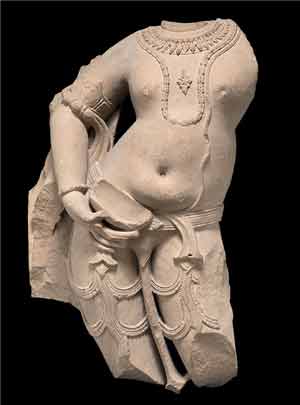
Fig. 18 Balarama as the eighth avatar of Vishnu, Madhya Pradesh, 11th century. Cat. 31.
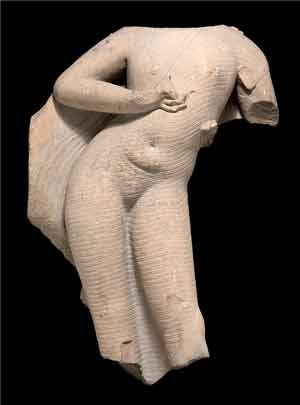
Fig. 19 Buddha as the ninth avatar of Vishnu, Madhya Pradesh, 11th century. Cat. 42.
As the Cosmic
Preserver, not only does Vishnu riding on Garuda roam the universe, but to save the world and his devotees or to restore moral order, he also periodically
descends (avatirna) to earth as an avatar. By the Gupta period, a group of ten avatars (Dashavatara) came to be especially recognized. The
exhibition includes a relief of Vishnu with all ten avatars represented together around the lotus halo (fig. 17, cat. 15). Two sandstone sculptures in the
museum’s collection depicting Balarama (fig. 18, cat. 31) and the Buddha (fig. 19, cat. 42), the eighth and ninth avatars, respectively, are well known and
rare examples of what must have been an impressive series of sculptures for a Dashavatara temple.
Buddha is the only certain historical figure among the ten, the last, Kalki, being still awaited. [4] It is an exemplar of the tolerant attitude
of the Hindus that they adopted as a divine incarnation the founder of what they otherwise consistently characterize in the Puranic literature as a heretic
religion. Significantly, Mahavira was not so honored, probably because of the extremism of Jain beliefs as well as the larger following of Buddhism at the
time, but Rishabhanatha was accepted as a minor avatar of Vishnu. The Jains further adore Krishna, who is said to be a cousin of the twenty-second Jina
Neminatha. Ironically, however, it was Buddhism that later lost its popularity in the Indian subcontinent, while Jainism still survives harmoniously with
its identity intact. [5]
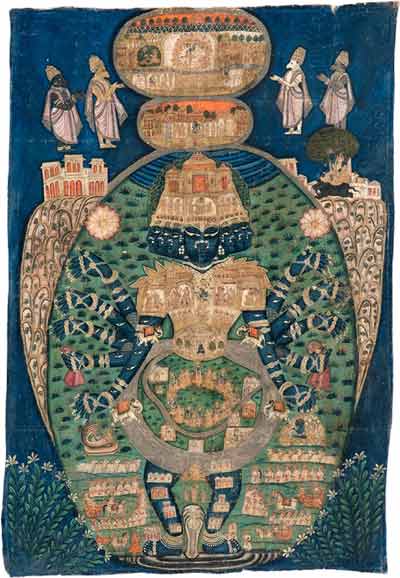
Fig. 21 Krishna as seen by Arjuna in his cosmic form,
Rajasthan or Gujarat, 19th century. Cat. 54.
Among the other avatars, the exhibition includes several representations of Narasimha, the Man-Lion (see cats. 27–30), and of Rama, the hero of the epic Ramayana (fig. 20, cat. 35; see also cats. 36 and 37). It should be noted that most Hindus believe Rama was a historical figure and an ideal
ruler; the expression Ramrajya (the rule of Rama) has come to mean good governance. In the Tanjore reverse glass painting, the only example of the
technique introduced in India in the 18th century by immigrant Chinese artists, we glimpse a view of the ideal court of Rama. Flanking the green Rama and
the fair Sita are Lakshmana displaying humility with crossed arms and a diminutive Hanuman (also green) in the attitude of devotion with his tail hanging
down between his legs (cat. 36). The influence of a modern formal photographic portrait is evident.
Even though Shiva is the archetypal ascetic God and the
primal yogi, his hair is arranged in a jatamukuta (crown [mukuta] of matted hair). A tiger skin drapes his hips, and human skulls and
serpents are his ornaments; yet, despite these symbols of asceticism, he is often shown bedecked in jewelry as befitting a king. The exhibition includes a
variety of his representations from different periods that reflect his diverse imagery, the simplest being his symbolic form in a linga (literally
“sign” and likely a word of non-Sanskrit origin), signifying both his generative organ and a cosmic pillar, while others are anthropomorphic and mythic
figures (see cats. 61–63). Most of Shiva’s forms are pacific, but in some he is presented in his angry manifestation known as Bhairava, a later variation
of Rudra of Vedic literature (see fig. 15). Here he is the Cosmic Destroyer of the Puranic triad where Brahma is the Creator and Vishnu the Preserver.
No
one who has witnessed religious processions or gaily dressed statutes in Catholic Latin America will be surprised to see the wide use of additional
clothing for the principal deities in Hindu temples and shrines, public and domestic. Indeed, the most suitable expression of this dressage would be
“regal,” both for the materials used and for the adornments, sometimes so profuse that only the deity’s eyes may be visible to the eager devotee. To
complete the regal imagery, a tiara or crown is often added, even when the sculpted or modeled head beneath is already embellished. Generally, however, it
is more common to use a piece of plain red cotton garment on the figure in Hindu temples, while a yellow piece drapes a Buddha and the Shvetambara Jains
employ a length of white cloth.
Just as the Sanskrit word bhagavan (possessor of fortune or share) is freely used by the Hindus to characterize
Gods, so, too, the Jains and Buddhists honor their liberated teachers by the same qualifier, such as Bhagavan Buddha or Bhagavan Mahavira. In a similar
fashion, the expression maharaja or maharaj (great king) is a common form of honorific address for both holy men and divinities by the
followers of all three faiths.
The spiritual majesty of the Buddha is emphasized in early Buddhist texts when he was declared the “King of Righteousness.”
While the early representations of the historical Buddha are not literally crowned, the seat is a lion-throne (simhasana). In later Vajrayana
ritual, it became obligatory to represent the “body of bliss” (sambhogakaya) suitably adorned and crowned. Tantric initiatory rites for spiritual
transformation are similar to royal consecration ceremonies. [6] The Jains, in due course, adopted similar abhisheka or initiatory rites
and embellished the abstract, stylized images of their liberated or omniscient teachers with trappings of kingship, such as the triple umbrella above, the
flywhisks held by attendants, and lustrating elephants (cats. 126 and 127). Finally, the last sermon of the liberated being in the Hall of Universal
Sermon, or the samavasarana, is conceived as a grand audience or durbar as befits a universal monarch (cat. 124).
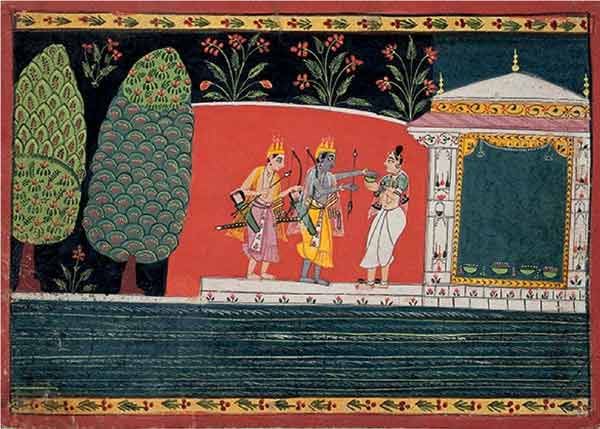
Fig. 20 Rama and Lashmana approach a hermitage, Malwa, ca. 1680s. Cat. 35.
The Eminence of Krishna
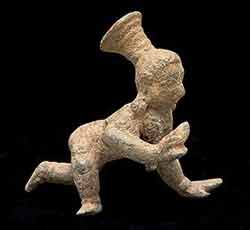
Fig. 22 An infant Krishna cradling a butter ball,
Tamil Nadu, 16th century. Cat. 43.
The most complex and charismatic Vaishnava, or even Hindu, deity represented in the exhibition is Krishna. He is the friend, counselor, and charioteer of
Arjuna of the epic Mahabharata, for whom he brilliantly summarizes on the battlefield of Kurukshetra the essence of Hindu philosophy and theology
in a poem called the Bhagavadgita that has become globally famous today. In a remarkable Rajput painting in the exhibition, we encounter Krishna’s Vishvarupa, or Universal Form; when to convince Arjuna, he demonstrates that everything in the universe owes its origins to him (fig. 21, cat.
54). To enable Arjuna to behold this awesome cosmic form, Krishna gives him divine sight, literally yogamishvaram, or yogic empowerment. [7] Clearly, here Krishna resorts to a visual image when he is unable to persuade Arjuna with lengthy rhetoric.
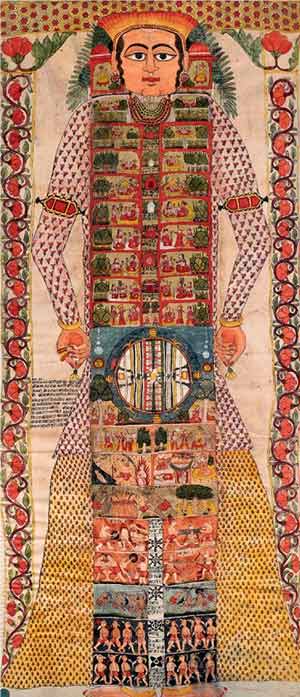
Fig. 25 Lokapurusha, Cosmic Man,
Gujarat or Rajasthan,
18th–19th century. Cat. 137.
The Bhagavadgita is believed to have been composed about the time the earliest objects included in this exhibition were made, and advocates
several ways to salvation, one of which is the path of yoga, already discussed, and another that of bhakti or devotion, which is expressed through puja and
piety. Interestingly, while presenting the brief for war involving violence, the philosopher-God exhorts Arjuna that for personal salvation, unwavering
faith in him, or for that matter any other deity, is a desideratum. [8] This steadfast devotion also forms the crux of some of the avatar myths,
such as that of Narasimha, when the boy devotee Prahlada is saved while the doubting Thomas of a king, Hiranyakashipu, is destroyed. A graphic work in the
exhibition further demonstrates the theme of bhakti when Vishnu appears before another young devotee called Dhruva or Steadfast (cat. 17).
In the early and
traditional group of ten avatars, at least until the 12th century, Krishna is excluded in favor of his foster brother, Balarama. Both, however, were humble
cowherders of Vrindavan rather than the kshatriya prince of Dwarka, who counseled Arjuna in the battlefield. It is this dark cowherder lad who is the
flute-playing darling of the cowherder girls, scourge of the evil ruler Kamsa of nearby Mathura (whom he finally destroys though he does not sit on the
throne himself), and, ultimately, the great lover of the singular cowherder girl Radha, who became the focus of popular devotion across the subcontinent.
Krishna is also the most popular figure among the exhibits. His adventurous and mischievous feats have inspired generations of artists to sculpt or paint
innumerable representations with both imagination and emotional intensity. No other Hindu deity embodies love in all its major psychological states with
such perception and empathy. One can worship him as a mischievous crawling infant with a butter ball (fig. 22, cat. 43), a dancing toddler (fig. 23, cat.
44), or an adolescent hero (fig. 24, cat. 47)—a youthful flute-player enchanting the cowherder girls, which became the favorite image of the God during the
last five centuries of the millennium, especially in northern India. The exhibition includes multiple depictions of this form of Krishna—an extraordinary,
richly carved, large wooden panel from Odisha, which may have been used as a temple door (see fig. 34, cat. 48), as well as stone and metal images intended
for domestic shrines (see cats. 45–47).
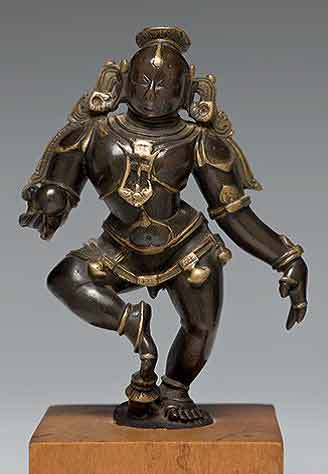
Fig. 23 A dancing toddler Krishna, Tamil Nadu, 17th century. Cat. 44.
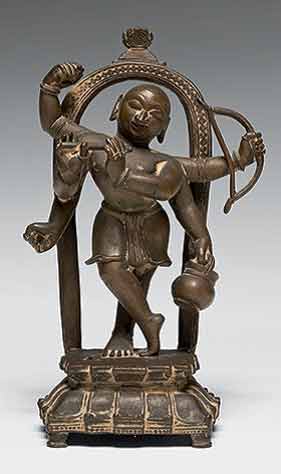
Fig. 24 A cosmic six-armed flute-playing Krishna, Odisha or Bengal, 19th century. Cat. 47.
Devotional Paintings
No deity has inspired and influenced the art of painting as ubiquitously as Krishna, as is clear from the number and diversity of pictures of this God in
the exhibition. Also included are a few devotional pictures created in the 19th century around the famous Kali temple in Kolkata in a distinctive style
that has come to be known as the Kalighat school (see cats. 32, 52, and 53). While these freely limned images were popular with pilgrims, the school also
delineated contemporary societal and satirical themes that were popular with visitors both native and foreign. Buddhists also produced vast quantities of
portable paintings on cloth and paper at their monasteries and shrines, which have not survived in India but were preserved in Nepal and Tibet, where they
strongly influenced local pictorial traditions.
However, the oldest surviving paintings on cloth in India are those commissioned by the Jains. [9] Several Jain paintings of different sizes and
periods are included in the exhibition and are discussed by John Cort in his essay, but a few additional comments here would not be out of place. The Jain
pictorial works in the exhibition not only show remarkable diversity of size, medium, and subject, but serendipitously help us to understand the history of
Indian painting over four centuries. They include manuscript illustrations on paper that, in the distinctive style of western India, depict in miniature
the stereotypical narrative of the lives of the Jinas and teachers (cats. 134 and 135), as well as monumental paintings on cloth or paper with
cosmographical or cosmological themes (cats. 121 and 122) and complex topographical compositions of famous pilgrimage sites such as Shatrunjaya (cat. 139).
There is also an abstract, modernist picture of Lokapurusha, or Cosmic Man (fig. 25, cat. 137) corresponding to the
Vishvarupa of the Bhagavadgita discussed above (see fig. 21, cat. 54). The cosmographical pictures are the only survivals of the ancient tradition
of mandala painting, lost on the subcontinent but enduring elsewhere in Asia. In fact, the exhibition includes rare three-dimensional examples of Jain
mandalas in stone and metal (cats. 118–120).
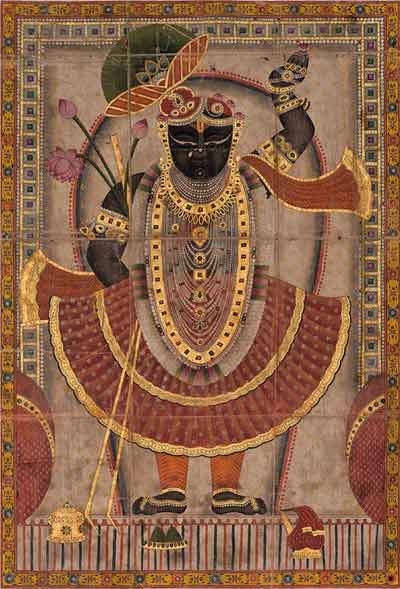
Fig. 26 Shrinathji, the form of Krishna worshipped at Nathdvara,
Rajasthan, 19th– 20th century. Cat. 56.
Such large paintings were also produced by the Vaishnavas, who lived in the same geographic and cultural zone
as the Jains in western India and in the Vaishnava stronghold in Odisha on the east coast. A number and variety of objects in the exhibition are from two
leading centers of Krishna worship: Puri in the state of Odisha and Nathdvara in the desert state of Rajasthan. Both are important pilgrimage sites for
devout Vaishnavas and are visited annually by millions of pilgrims.
The Puri temple dedicated to Jagannath (Lord of the World) is the older shrine, while
Nathdvara was established in the 16th century by the charismatic philosopher-teacher Vallabhacharya (active 1481–1533). Both temples have had enormous
influence among Hindu courts and communities far beyond their location. Arts created for devotees and pilgrims at the two centers have influenced
devotional imagery elsewhere. Several of the Nathdvara style of monumental paintings with diverse subjects and forms reflect with visual panache the glory
of Krishna’s divine splendor (fig. 26, cat. 56), while the select smaller examples on paper in a wide variety of styles with narrative content as well as
literary conceits depict what is characterized in literature as Krishnalila, or the Divine Play of Krishna.
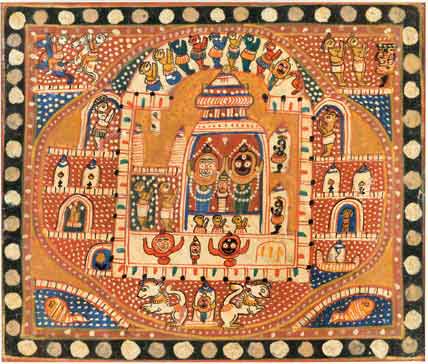
Fig. 27 The Jagannath temple triad, Odisha, late 19th–20th century. Cat. 34.
The Jagannath temple of Puri is an ancient
shrine of even greater antiquity than the current impressive 13th-century temple complex visited by countless Hindu pilgrims. Consisting of a triad, the
deities are identified as Krishna as Jagannath, his brother, Balabhadra (Balarama), and their sister, Subhadra, a manifestation of the great Goddess. Even
their iconographic representations (cat. 33; fig. 27, cat. 34) are unusual to say the least: they reflect a tribal aesthetic and are among the most exotic
and geometric forms used in a major Hindu temple. It should be mentioned that not only do local tribal communities participate in the temple ritual but
every twelve years the timber images in the main shrine are replaced with freshly carved examples intended to be impermanent, whereas most principal images
in temples of all three religions are created of stone or metal for greater permanence.
In both paintings, besides the triad, the ten avatars are included
as in the much earlier stele from the west (see fig. 17, cat. 15), but here the Buddha is replaced by Krishna as Jagannath. This must have happened after
Jayadeva, for in his (ca. 12th century) lyrical Sanskrit poem Gitagovinda (sung daily at the Puri temple), the poet retains Buddha in his
beautiful invocatory eulogy to the ten avatars; “moved by deep compassion,” he “condemned the Vedic way that ordains animal slaughter in rites of
sacrifice.” [10]